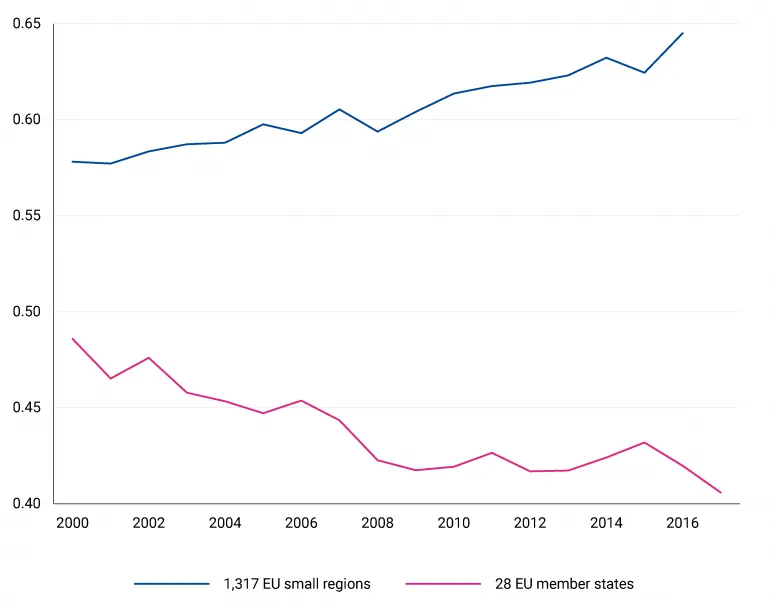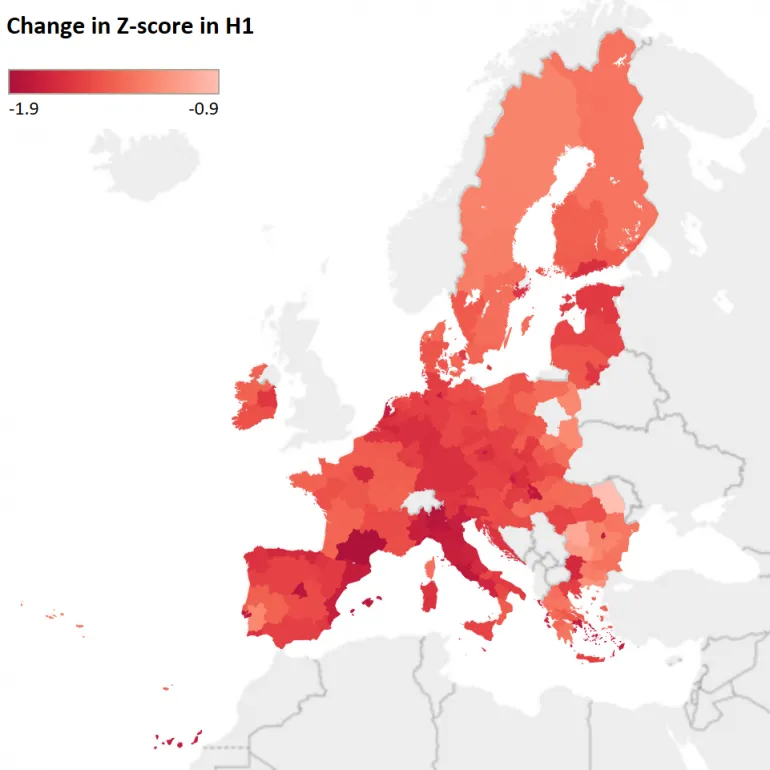About the ESM blog: The blog is a forum for the views of the European Stability Mechanism (ESM) staff and officials on economic, financial and policy issues of the day. The views expressed are those of the author(s) and do not necessarily represent the views of the ESM and its Board of Governors, Board of Directors or the Management Board.
Addressing the risk of regional disparities

The economic impact of the coronavirus may deepen regional disparities and worsen the risk of divergence within Europe. To reinforce the stability of the euro area and Europe, policies have to address these risks and strengthen convergence. Given the current de-globalisation trend, there is an increasing need for a well-functioning and equitable EU single market. The “Next Generation EU” can be a vehicle for such reforms.
The Covid-19 pandemic has caused the deepest recession in Europe for a century. While the pandemic is a threat to the health of all European people, it has had an uneven impact across economic sectors, regions and countries. The longer the pandemic lasts and the stronger the economic impact, the higher the risk that it will lead to structural, longer-term differences.
The European Union has been taking measures to address the asymmetric impact of the pandemic and to emerge from this crisis without an increase in inequality. In this context, our blog post highlights the dynamics of regional disparities over the past 20 years, and the policy measures that can mitigate the risks of sustained fragmentation following the current crisis.
The risk of regional disparities
The question of regional disparity is a serious concern in Europe. Some of the poorest regions in member states that joined the EU more recently are catching up to the EU average, but others are falling behind. We found symptoms of a regional ‘middle-income trap,’ as a quarter of small regions in older member states are exposed to a widening negative income gap compared with the EU average (see Figure 1).
Figure 1: Disparities across member states have been declining, but rising across regions (Dispersions of regional income per capita since 2000, coefficient of variation)

Note: The coefficient of variation is a standardised measure of dispersion. It is the ratio of the standard deviation to the mean. The higher the coefficient of variation, the greater the level of dispersion around the mean and the larger the disparity. 1,317 small regions refers to OECD regional breakdown of EU28.
Source: ESM based on OECD Regional Database.
Economic integration is an important source of growth, but it leads to convergence only if conditions are right. Evidence provided by our recently published analysis shows that there are inherent advantages of being geographically close to an economic centre of gravity. Given regional differences, European integration can reinforce the very uneven impact of global value chains, unless managed carefully.
The pandemic has broken trade linkages and has temporarily disrupted the EU’s labour market. The immediate impact of this crisis has been more severe in urban areas, with a higher concentration of services directly affected by restrictions, and in regions more reliant on tourism (see Figure 2). Over time, other areas may face a delayed economic impact, as weak demand and disruptions to mobility spread across the economy. Sectors with less possibility for remote working may be hit harder the longer social distancing constrains work, putting incomes and jobs at risk.
Figure 2: Uneven initial impact of Covid-19 on labour market across regions in first half of 2020 (Change in job vacancy rates according to sectoral composition, expressed in Z-score)

Note: Weighted average change in sectoral vacancy rates expressed in Z-score. The regional index is calculated from the sectoral vacancy rates weighted by the respective sector’s share in employment in each region, expressed in Z-score. Z-score is a measure of difference compared to average expressed in standard deviations. -1 means that the weighted average vacancy rate for the region declined by 1 standard deviation over the first half of 2020.
Source: ESM based on Eurostat.
The longer-term economic impact will likely differ across regions, depending on their exposure to particular sectors, and their integration into global value chains. It has also been suggested that employment may be at higher risk in countries and regions that rely more on small- and medium-sized enterprises.
The current crisis will affect the regional economies for a very long time without the right policies in place. We have seen in the aftermath of the previous crisis how persistent damage from high unemployment (so-called “hysteresis”) can aggravate regional disparities. At that time, the most affected regions experienced persistently lower employment and weaker investment, while less affected regions rebounded. A pattern of outward migration emerged from the “lagging” regions, towards the “leading” regions, as regions with higher productivity growth attracted more entrants.
There have been calls for de-globalisation and a more inward looking “repatriation” of production, but this would be a mistake, as it would undermine growth both globally and in the euro area.
Regional patterns of inequality suggest a greater complexity than simple urban-rural or north-south differences. Sectoral compositions and productivity differences appear to be part of the explanation. Furthermore, trade diversification can be an opportunity for lagging regions to catch up and enter markets that were so far not available.
So, what supports regional convergence? Regional institutional capacity and quality of education have a positive impact on convergence. Inflexible labour markets, however, seem to have an unfavourable effect on regional income growth within the euro area, according to our findings. Regions with smaller fiscal buffers, lower savings, and less fiscal space may find sectoral adaptation more challenging. The crisis is resulting in increased expenditures and reduced revenues for regional governments, and while its impact on subnational finance is not uniform, it is expected to be long-lasting.
Policy measures to avoid fragmentation
National and European policy responses provide significant financial resources to overcome the short-term and medium-term financing constraints facing companies and banks. Countries and European institutions are providing additional means of fiscal support, focusing in particular on forward-looking investments (such as education), digitalisation and greening the economies. In this context, we suggest the following key elements to avoid further divergence and to reinvigorate convergence in Europe:
- A well-calibrated industrial policy can help boost productivity beyond leading clusters more broadly, setting the scene for a catch-up process in lagging regions.
- A two-track approach to improve labour supply through education and attracting investment to generate labour demand and enhance productivity. This will require education designed to retain qualified people. Also, the role of research and development and innovation-enhancing policies needs to suit the comparative advantages of the region or urban area, with EU funds focused, for example, on helping to develop high quality research and education centres.
- As global trade relations come under pressure, both due to the pandemic and for geopolitical reasons, Europe will have to build on the benefits of a flexible and equitable single market. In particular, Europe should move towards a better working EU single market for services. Global value chains can be complemented by “European value chains” connecting all regions.
- The productivity catch-up of lagging regions will also depend on the interaction and linkages with leading regions. Connections include transport links, access to finance, and cooperation with the universities and research centres. Areas where policy intervention can make a difference encompass innovation, information and communications technology infrastructure and measures to support digital growth; the digital economy provides opportunities for small- and medium-sized enterprises to play a more active role in global value chains, where they have been under-represented.
- The recent experience of the lockdowns should also give new impetus to think about labour mobility. On the one hand, mobility restrictions jeopardise the spirit of the free movement of persons, one of the EU’s four fundamental freedoms. Even if they are necessary to control the pandemic, these measures must be designed in a way that they do not lead to unemployment in the euro area. On the other hand, the increase in teleworking can reinforce a single labour market as the geographic location of workers becomes less important in many sectors. This development can help many regions that are lagging behind in economic terms.
- Last but not least, the quality of national, regional, and local administration plays an important role in supporting convergence. Inward investment will take place when corruption is absent, administrative procedures work swiftly, and the outcomes of administrative and legal proceedings are predictable.
Outlook
The underlying processes that cause some regions to profit more from integration than others will not vanish in the future, but policy action can help to address those processes. Importantly, European support during the recovery phase from the pandemic crisis will be linked to economic reforms in the context of the “Next Generation EU” initiative. National-level policies should be aligned with the European Semester to address this risk of divergence and to reinforce economic and social stability. The “Next Generation EU” should therefore be a vehicle to enforce the needed reforms.
It is one of the basic tenets of EU integration to support the development of weaker regions, and it would be economically and politically unacceptable for regions to slowly decline. Therefore, EU and national economic policies need to re-examine ways to mitigate and eventually reverse these processes. Managing both, the pandemic and the recovery in the right way provide an opportunity to forge sustained convergence.
Footnotes
International production, trade and investments are increasingly organised within so-called global value chains (GVCs) where the different stages of the production process are located across different countries. Firms try to optimise their production processes by locating the various stages across different sites. The past decades have witnessed a strong trend towards the international dispersion of value chain activities.
Further reading
Blog manager

